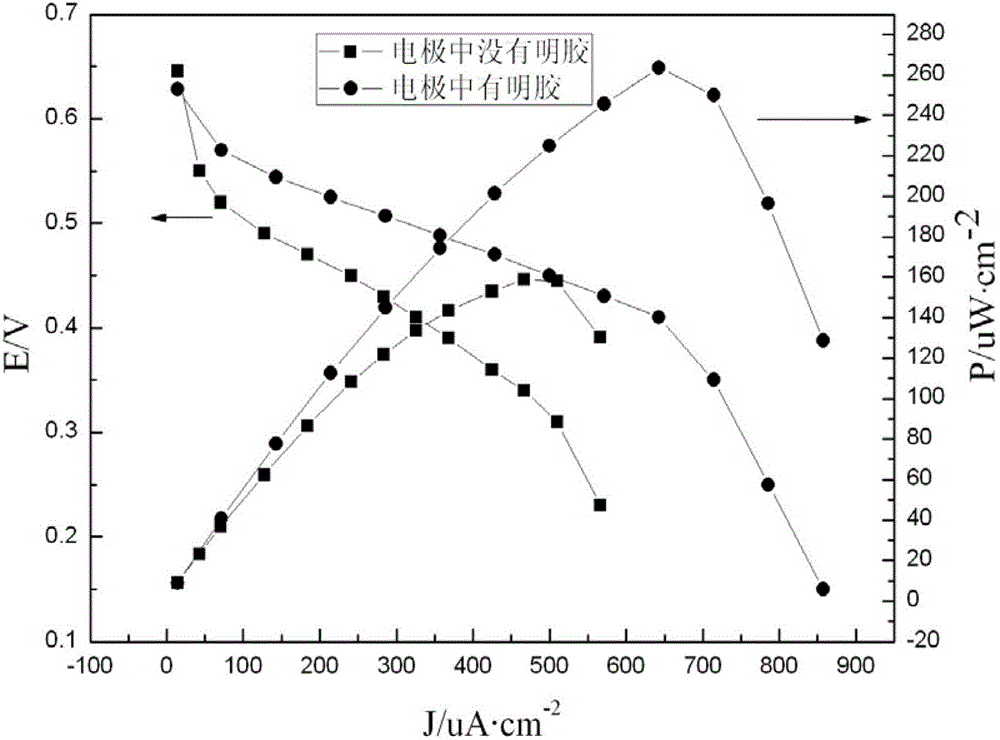Enzyme biological fuel cell positive pole and preparation method and application thereof
A biofuel cell and anode technology, applied in biochemical fuel cells, battery electrodes, circuits, etc., can solve the problems of affecting performance, prone to agglomeration, poor dispersion, etc. Effect
- Summary
- Abstract
- Description
- Claims
- Application Information
AI Technical Summary
Problems solved by technology
Method used
Image
Examples
Embodiment 1
[0044] I, preparation of enzyme biofuel cell bioanode Gel1 / CNT / BSA / GOD:
[0045] (1) Take a certain amount of short multi-walled carbon nanotubes, with a diameter of 20-30nm and a length of 0.5-2μm, soak in acetone for 30 minutes, then filter, wash with distilled water, and dry. Then the cleaned carbon nanotubes were added with H 2 SO 4 / HNO 3 (3:1, volume ratio) in mixed acid solution at 30°C, 100Hz ultrasonic for 6h, filtered, cleaned with distilled water, dried in vacuum, and set aside.
[0046] (2) Take 4mg of carbon nanotubes treated in step (1), add 1ml of 0.1% by mass gelatin aqueous solution, and ultrasonicate at 40°C for 6 hours at 100Hz to obtain a multi-walled carbon nanotube gelatin composite dispersion.
[0047] (3) Take carbon paper with a size of 1×1 cm, soak it in acetone solution for 30 minutes, then wash it in distilled water, and dry it in a vacuum oven at 100°C for 12 hours under vacuum.
[0048] (4) Evenly drop 1ml of the multi-walled carbon nanotube g...
Embodiment 2
[0054] I, preparation of enzyme biofuel cell bioanode Gel3 / CNT / BSA / GOD:
[0055] (1) Same as step I (1) of Example 1.
[0056] (2) Take 4 mg of carbon nanotubes treated in step (1), add 1 ml of 0.3% by mass gelatin aqueous solution, and sonicate at 40° C. for 6 hours to obtain a multi-walled carbon nanotube gelatin composite dispersion.
[0057] (3) Same as step I (3) of Example 1.
[0058] (4) Evenly drop 1ml of the multi-walled carbon nanotube gelatin composite material dispersion prepared in step (2) onto the surface of the carbon paper cleaned in step (3), and dry.
[0059] (5) Take 1ml of BSA / GOD mixture (wherein, the final concentration of BSA is 1% by mass, and the ratio of BSA and GOD is 1:1 by mass) and drop it on the surface of the carbon paper treated in step (4), Add 0.1ml of 0.3% by volume glutaraldehyde dropwise, place it at 4°C for 12h, and rinse off excess substances with distilled water. Connect the silver wire to the carbon paper to obtain the enzyme bioan...
Embodiment 3
[0062] I, preparation of enzyme biofuel cell bioanode Gel32 / CNT / BSA / GOD:
[0063] (1) Same as step I (1) of Example 1.
[0064] (2) Take 2 mg of carbon nanotubes treated in step (1), add 1 ml of 0.3% by mass gelatin aqueous solution, and sonicate at 40°C for 6 hours to obtain a multi-walled carbon nanotube gelatin composite dispersion.
[0065] (3) Same as step I (3) of Example 1.
[0066] (4) Evenly drop 1ml of the multi-walled carbon nanotube gelatin composite material dispersion prepared in step (2) onto the surface of the carbon paper cleaned in step (3), and dry.
[0067] (5) Take 1ml of BSA / GOD mixture (wherein, the final concentration of BSA is 1% by mass, and the ratio of BSA and GOD is 1:1 by mass) and drop it on the surface of the carbon paper treated in step (4), Add 0.1ml of 0.3% by volume glutaraldehyde dropwise, place it at 4°C for 12h, and rinse off excess substances with distilled water. Connect the silver wire to the carbon paper to obtain the enzyme bioano...
PUM
| Property | Measurement | Unit |
|---|---|---|
| diameter | aaaaa | aaaaa |
| length | aaaaa | aaaaa |
Abstract
Description
Claims
Application Information
 Login to view more
Login to view more - R&D Engineer
- R&D Manager
- IP Professional
- Industry Leading Data Capabilities
- Powerful AI technology
- Patent DNA Extraction
Browse by: Latest US Patents, China's latest patents, Technical Efficacy Thesaurus, Application Domain, Technology Topic.
© 2024 PatSnap. All rights reserved.Legal|Privacy policy|Modern Slavery Act Transparency Statement|Sitemap

